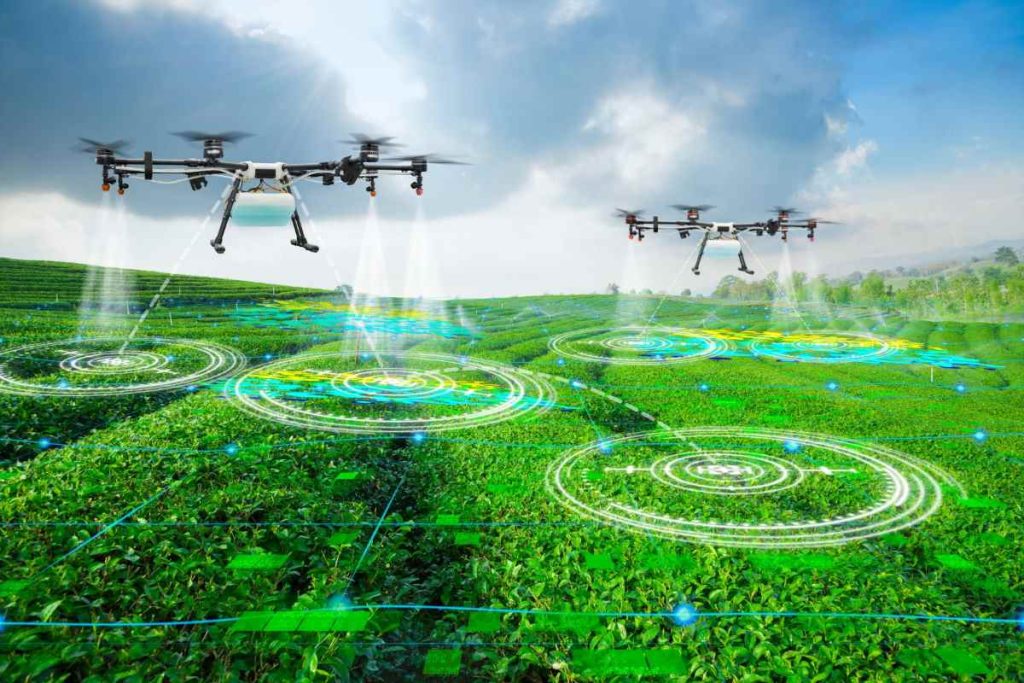In recent years, the integration of technology in agriculture has revolutionized traditional farming practices. One of the most notable advancements is the use of drones in agriculture. Unmanned Aerial Vehicles (UAVs), commonly known as drones, have emerged as powerful tools for enhancing crop monitoring and management. This article delves into the various applications of drones in agriculture, their benefits, challenges, and the future prospects of this transformative technology.

Overview of Drones in Agriculture:
Definition and Types of Agricultural Drones:
1. Definition of Agricultural Drones:
Agricultural drones, or UAVs, refer to unmanned aerial vehicles designed specifically for use in farming and agricultural practices.
2. Types of Agricultural Drones:
Fixed-Wing Drones: Designed like traditional airplanes, these drones cover large areas efficiently.
Rotary-Wing Drones: Helicopter-like drones suitable for more precise and flexible operations.
Components and Features of Agricultural Drones:
1. Key Components:
Sensors: Various sensors, including multispectral and hyperspectral cameras, are used for data collection.
GPS Systems: Ensure accurate mapping and navigation.
Communication Systems: Facilitate real-time data transmission.
2. Special Features:
Automated Flight Systems: Pre-programmed flight paths for efficient coverage.
Payload Capacity: Ability to carry various payloads, such as cameras, sensors, and even pesticide dispensers.
Applications of Drones in Agriculture:
Crop Monitoring:
Remote Sensing:
Multispectral Imaging: Detects variations in crop health by capturing different wavelengths of light.
Thermal Imaging: Identifies temperature variations, aiding in stress detection.
Disease and Pest Detection:
Early Identification: Drones equipped with sensors can detect diseases and pests before visible symptoms appear.
Precision Agriculture: Enables targeted treatment, reducing the need for widespread pesticide use.
Precision Agriculture:
Soil Analysis:
Topography Mapping: Drones create detailed 3D maps for precise soil analysis.
Nutrient Monitoring: Helps optimize fertilizer application, reducing waste and environmental impact.
Irrigation Management:
Water Stress Detection: Drones identify areas with inadequate irrigation.
Water Distribution: Optimize irrigation patterns for efficient water use.
Crop Spraying:
Pesticide and Fertilizer Application:
Automated Spraying: Drones provide accurate and targeted application, minimizing chemical usage.
Reduced Environmental Impact: Lower chemical runoff and contamination.
Crop Seeding:
Precision Seeding: Drones enable precise seed placement, improving crop yield and reducing waste.
Benefits of Drones in Agriculture:
Increased Efficiency:
Time Savings: Drones cover large areas quickly, reducing the time required for manual inspection.
Cost-Effective: Drones offer a cost-effective alternative to traditional methods of monitoring and management.
Enhanced Precision:
- Accuracy in Data Collection: High-resolution imagery and sensor data provide accurate insights.
- Targeted Interventions: Precision agriculture practices minimize resource use while maximizing crop yield.
Improved Crop Yield and Quality:
- Early Detection of Issues: Timely identification of diseases, pests, and nutrient deficiencies leads to proactive interventions.
- Optimal Resource Management: Drones assist in optimizing water, fertilizers, and pesticides, contributing to higher crop quality.
Challenges and Considerations:
Regulatory Challenges:
- Airspace Regulations: Integration of drones into agricultural practices requires adherence to aviation regulations.
- Privacy Concerns: Balancing the benefits of drone technology with privacy considerations is crucial.
Technical Challenges:
- Battery Life: Limited battery life may restrict the operational time of drones.
- Sensor Accuracy: Ensuring the accuracy and reliability of sensors is essential for precise data collection.
Initial Investment:
- Cost of Technology: The initial investment in drones and associated technology may be a barrier for some farmers.
- Training and Skill Development: Farmers need to acquire skills to operate and maintain drone systems effectively.
Future Prospects of Drones in Agriculture:
Advancements in Technology:
- Improved Sensors: Ongoing advancements in sensor technology will enhance data accuracy.
- Artificial Intelligence Integration: AI algorithms will enable more sophisticated data analysis for better decision-making.
Increased Adoption:
- Cost Reduction: As technology evolves, the cost of drone systems is likely to decrease, making them more accessible to a broader range of farmers.
- Government Support: Subsidies and incentives may encourage farmers to adopt drone technology.
Customization and Integration:
- Tailored Solutions: Future drones may be designed for specific crops or farming conditions.
- Integration with Other Technologies: Drones may be integrated with other smart farming technologies for a comprehensive solution.
Conclusion:
The integration of drones in agriculture represents a transformative shift in the way farmers monitor and manage their crops. From precision agriculture practices to crop monitoring and pest control, drones offer a range of benefits that contribute to increased efficiency, reduced environmental impact, and improved crop yield and quality. While challenges exist, ongoing technological advancements and increased adoption are poised to make drones an indispensable tool in modern agriculture. As we look to the future, the continued development of drone technology holds the promise of further revolutionizing the agricultural landscape.






